Library Legacy
1914-1922
In 1914 members of the Woman’s Club raised funds to purchase two lots on Davis Hill (currently on the corner opposite the Donut Haus); these lots were intended as the site for a new library but the plan never went forward. In 1916 the library took up residence at the Estes Park School, located at the corner of Park Lane and MacGregor Avenue. This first library had a collection of 262 books housed in one room in the school. Open two afternoons a week, and only during the school year, the library was run by Florence Bond. Her salary was $1.50 per week. By 1920, the library was forced to find other space in the Hupp Hotel, and in other retail establishments.


1922-1963
The Estes Park Woman’s Club raised $5,000 to build and furnish a small stone and stucco building in Bond Park, which opened in September of 1922.The name was officially changed to Estes Park Public Library and it was open five days a week.
Through the generosity of Mrs. Eleanor E. Hondius (pictured at right) and her son Pieter Hondius, Jr., an addition was added in 1935; it more than doubled the size of the library. Bond retired in 1941. Ora Carr, who had been the assistant since 1938, took over and stayed for 24 years.

1963-1970
Mrs. E.L. Lacey was appointed librarian in 1963. The library was open six days a week from 10:00 a.m. to 12:00 p.m., 2:00 p.m. to 5:00 p.m., and 7:30 p.m. to 9:00 p.m. In 1968, Mrs. Phyllis Hurt became the librarian. The Library Board (which was still comprised of members of the Woman’s Club) voted to join the new High Plains Library System, which offered workshops and help in “modernizing” library operations. The library was expanded and remodeled and the new building was dedicated in October of 1969. Hurt retired in 1970.
1970-1980
Ruth Deffenbaugh was hired as the librarian in 1970. She and Lennie Bemiss started the Colorado Collection and organized the volunteer effort that produced the newspaper index and the beginnings of the oral history program. By this time, the Town of Estes Park was providing a substantial amount of annual funding for salaries, utilities, insurance, etc. An addition of 900 square feet was added to the west side of the building in 1978. A Friends of the Library group was established in 1978 to “promote the use and awareness of the library’s resources and facilities and to provide and promote financial support.”
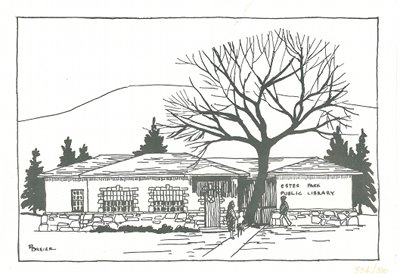
1980 – 1985
Ruth Deffenbaugh retired in 1980 and was replaced by Ted Schmidt. He was the first library director who was not a member of the Woman’s Club and also the first to have a Masters of Library Science degree. When Schmidt added Sunday hours in 1984, staff increased to 6 full time people. Thirty active volunteers contributed 2,100 hours of service. Schmidt served as director until his family moved to Missoula, Montana in 1985.
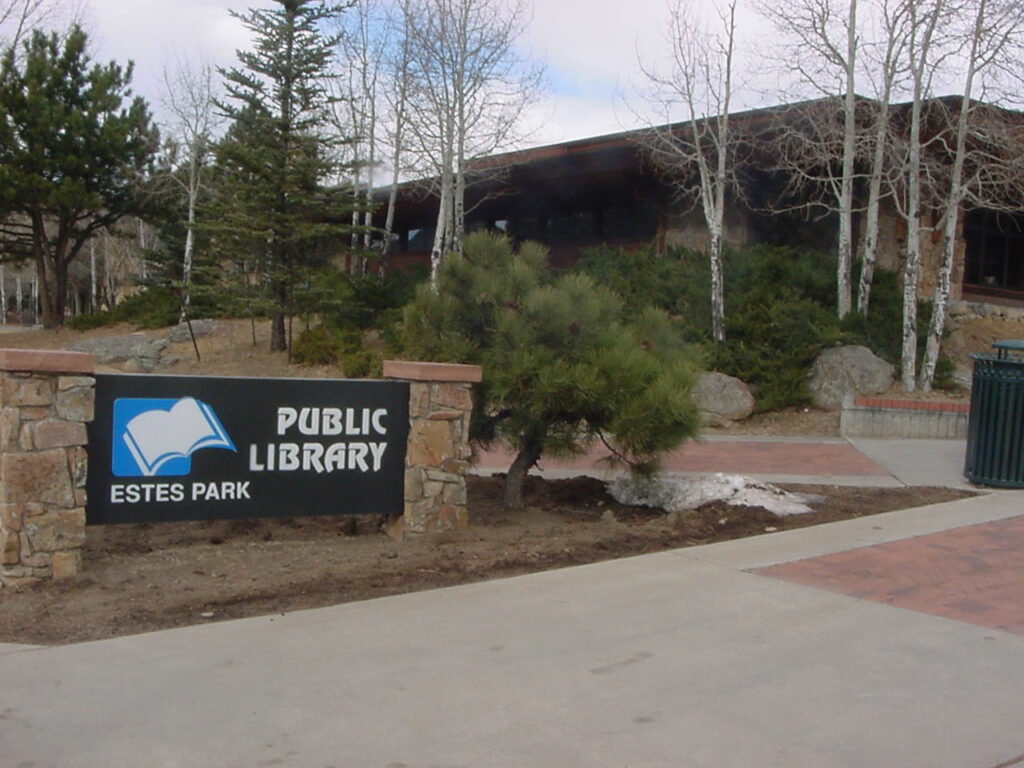
1985 – 1990
Judy Hoxsey was hired in 1985 to help develop a plan and build a new library. In addition, the Library Foundation was incorporated in 1985 “for the purpose of promoting and advancing the welfare” of the Library. Hoxsey organized a committee to pursue a site study for the new library in 1986; the southwest corner of the Municipal Parking Lot was chosen. In addition, Hoxsey conducted a campaign to establish permanent funding for the Library by offering a separate taxing district in 1988. The district would be funded by 2.5 mills on property tax within boundaries the same as the Hospital District. Voters approved the Estes Valley Public Library District on November 8, 1988.
1990 – 1998
In 1990, seven full time and three part time staff members began the huge task of inputting library holdings records into CARL (the new library computer system). More than 12,000 records were inputted by the end of the year and for the first time the library’s collection was automated. A fax machine, electric typewriter, three CARL terminals with a multiplexer and modem were added to help streamline workflow. The groundbreaking for the new library building took place on August 22, 1990. Staff began re-registration of 9,000 plus library cardholders for conversion to the CARL System in March 1991. On April 27th, 1991, Masonic Lodge number 183 laid the corner stone for the new library building. For two weeks in June books were moved with forklifts to the new location, and on June 23rd, 1991 the new building opened its doors to the public for the first time. In 1991 the library offered the first public access Internet station. In 1997, 4,615 computer users lined up to use four Internet computers. Hoxsey retired in May of 1998.
1998 – 2005
New library director Ed Volz arrived in September of 1998. The Library Board asked for a bond issue for $735,000 in bonds for library expansion in 1999. This issue failed but voters passed a separate issue approving an override of the TABOR amendment. This allowed the library to collect, retain, and expend all revenues that the current 2.39 mill levy would generate. This was also known as de-Brucing. The construction bond issue passed on its second try in 2000 to fund a second story addition, which opened in 2002. The Library migrated its online database from CARL to TLC in September 2001. At the suggestion of Volz, the Board asked for a mill levy increase in November 2004 to fund improved staff salaries and maintain current hours of operation. This was successful in large part due to the volunteer work of Don Widrig and Lee Lasson, who organized the YFTL “Yes for the Library” campaign.
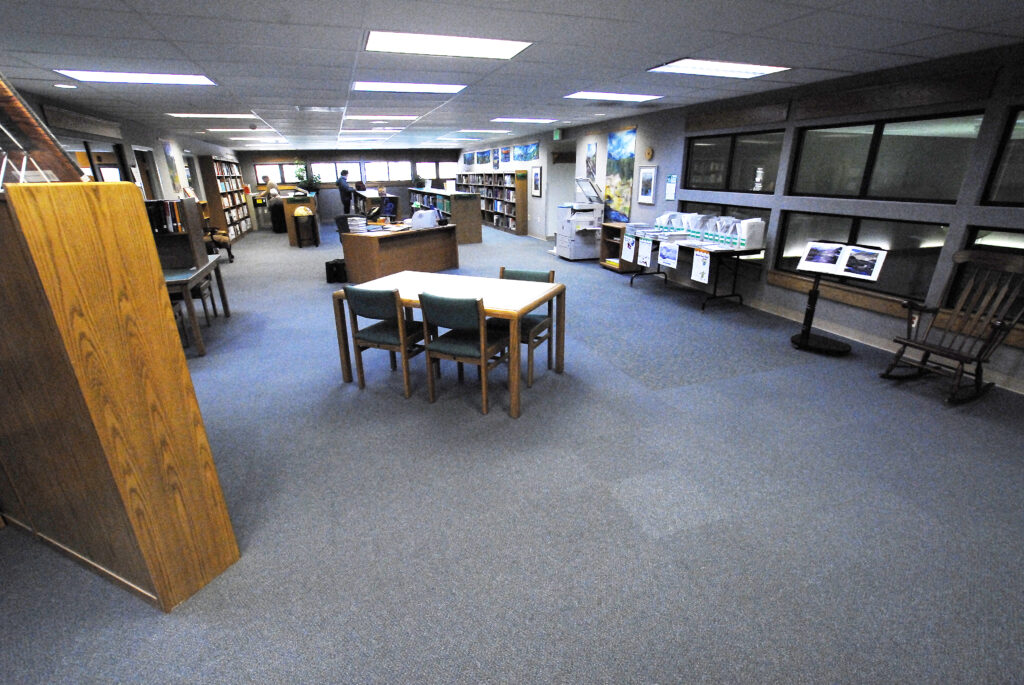
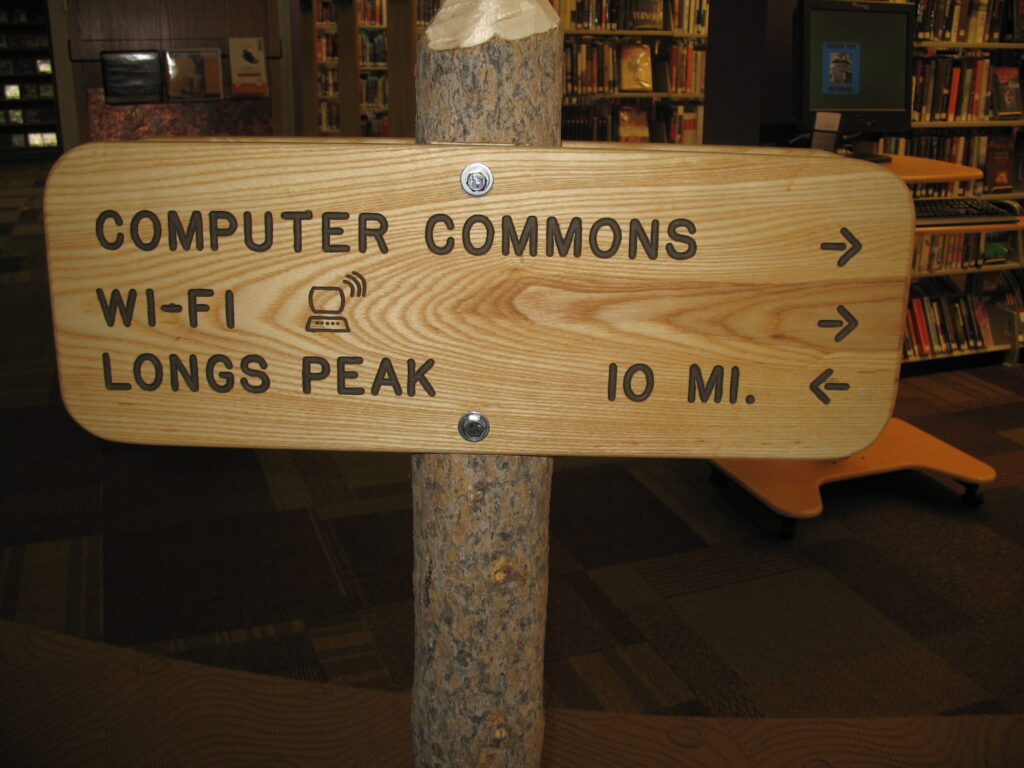
2005-2007
In 2005, the staff consisted of 9 full time employees with 8 part time or substitute workers. The collection contained approximately 45,710 volumes, 200 magazine subscriptions, 15 newspaper subscriptions and 5,886 audio books, music CDs, videos, DVDs, and CD-ROMS. Volz resigned on May 13, 2005. New director Claudine Perrault arrived at the end of September of 2005. In April and May of 2007, the 1st floor was remodeled and the computer commons was created on the second floor.
2008
In 2008 the library’s focus was turned more than ever towards providing resources for our children. Children’s programs were expanded and attendance at these programs totaled over 12,000. Due to generous grants from both the Library Foundation and the Friends of the Library, a renovation was undertaken and the children’s room was completely remodeled for 21st Century use. The now one-year-old computer commons area saw approximately 30,400 hours of patron usage and items were checked out over 181,000 times.
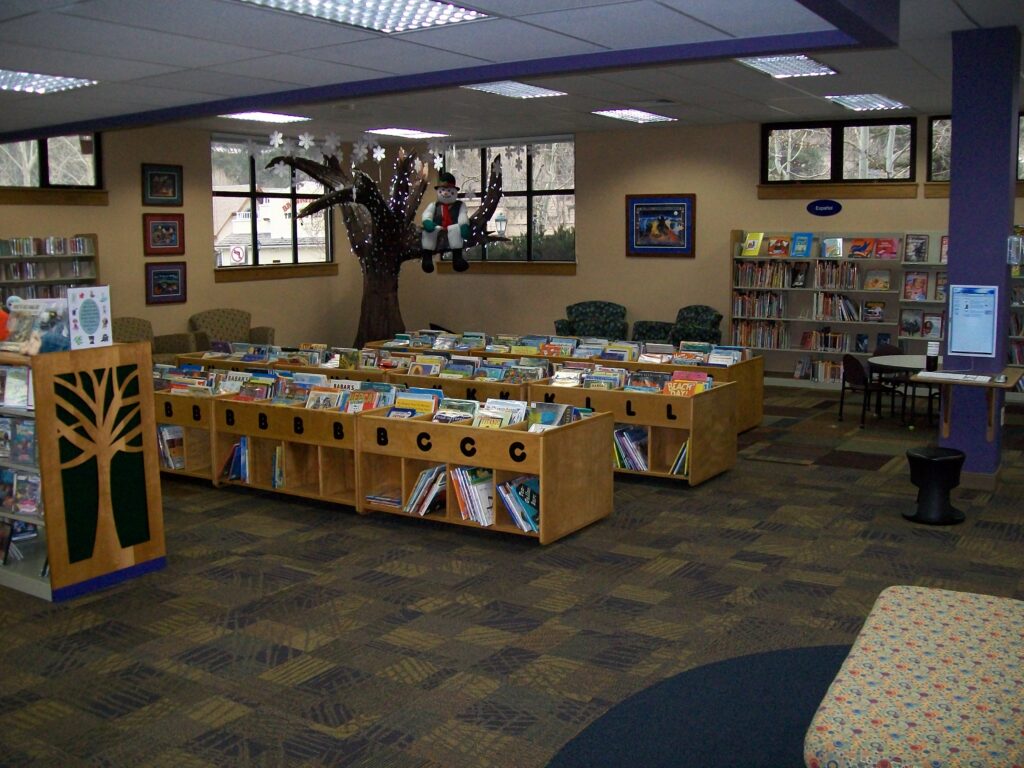

2009-2010
2009 was the ‘Year of the Archive’ with substantial funding coming from the Friends of the Library for improvements to the library’s Local History Collection. New shelving, numerous programs for the public, new history web pages, and the digitization of both historic newspapers and oral histories were among the projects taken on by the staff. In addition, 2009 saw a re-branding of the library with a new logo, new library cards, and a new name, the Estes Valley Library. In 2010, again with funding from the Friends of the Library, the upstairs staff office areas were remodeled.
2011
In 2011 the Estes Valley Library launched the first One Book One Valley, a series of community read programs. September kicked off with, “A Walk in the Woods” by Bill Bryson. The event ran through October and drew almost 1,000 participants. New emphasis was placed on staff development, with board-approved closure days dedicated to 21st Century skills. The popular financial literacy program, Common Cents Counts, received additional FINRA grant funding, making another year of financial programs possible. The library’s Internet connection speed was 10mb/sec and the first foray into social media began with Facebook.

2012
Automation continued to play a big role in library activities with the launch of the first digital collection service and RFID tagging of the entire physical collection. Two self-checkout stations were installed and were immediately used by 80% of cardholders. An automated RFID Book Return was also installed in the atrium. A library satisfaction survey was launched yielding data on library district strengths and weaknesses.
2013
Increased operating costs were taking a toll on the library’s ability to continue current service levels. Library stakeholders strategized funding approaches. Conclusion: 1) investing in fund development would yield new donor dollars, and 2) a $25/per average household increase in tax funding would prevent service cuts and add critical services requested by the public. A campaign was launched by library supporters for an increased mil levy, with high hopes for a successful November ballot.
The year was defined by the Flood of September 11. One Book One Valley went forward in the wake of the flood, with the redemptive story “Plainsong” by Kent Haruf. The Treasury of Gratitude project was launched to tell the stories of the many residents affected by the flood, and to express their gratitude to local businesses, volunteers, and community members for their help during the recovery.
Finally, Election Day arrived; and while the vote was close, the spirited people of the library district voted “Yes”. Beginning January 1, 2014, the library district’s property levy would grow from 3.28 to 4.52 mils.
2014
Fulfilling election promises, two new positions were created, and a Teen Guide and Tech Guide were hired.
In partnership with the Estes Park Museum, the library’s “Mountaineer Oral History project” was successfully finished, capturing stories of the early history of Estes Park and Rocky Mountain National Park mountaineers.
Five new children’s educational computers were added in the children’s computer room. With post flood funding from the Community Foundation of Northern Colorado a new computer lab was created and dedicated to supporting local businesses and employment in flood recovery.
The Library Director was awarded Colorado Association of Libraries “Librarian of the Year” in response to the library’s services to the community immediately after the 2013 flood.
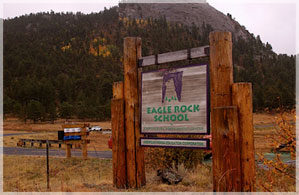
2015
A new and unique library branch was created at Eagle Rock School. A courier began running between the two locations five days a week. The library’s Internet connection speed was increased to 50 mb/s.
2016
2016 was a particularly exciting year as the community was invited to join in the celebration of the library’s centennial. The Estes Valley Library expanded its Youth and Family Services department with the hire of a Teen Librarian and an ELL Outreach Coordinator. With the addition of Overdrive and Hoopla, the library began offering over 300,000 titles for reading, listening, and watching. The local history archive collection was transferred to the Estes Park Museum over a period of six months. The library and museum partnered to plan the digitization of Estes Park’s historic newspaper collection.
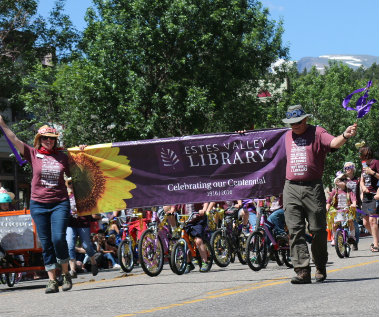

2017
After years of planning and two months of construction, the second floor’s new, functional design came to fruition. Thanks to five generous donors, the second floor now offered a Makerspace, Quiet Room with a fireplace, two additional study rooms, and an improved Computer Room.

Following a 2012 survey, the Estes Valley Library conducted a community study to gauge overall satisfaction levels of the services provided, how important those services were to different constituencies, and how to best reach the community in terms of its ongoing communication efforts. The results of this survey would help drive library goals into the future. 793 responses were received.
2018
In March, the library opened an off site pickup and dropoff location at the Estes Valley Community Center called The Twig (smaller than a branch). This project occurred after almost all community survey respondents indicated that lack of parking in the summer was a frustrating aspect of library use. Equipment for the Twig was funded by an anonymous donation to the Estes Valley Library Friends and Foundation. The mini branch included an automated locker system for holds pickup and a drive through book drop.
Library departments were restructured to include Program and Outreach Services which now encompassed adult, teen, children, family, and ELL programs; Patron Account Services which now staffed both service desks; Technical Services which acquired Facilities; and Administration. The library’s internet connection speed was increased to 1 Gb/s.
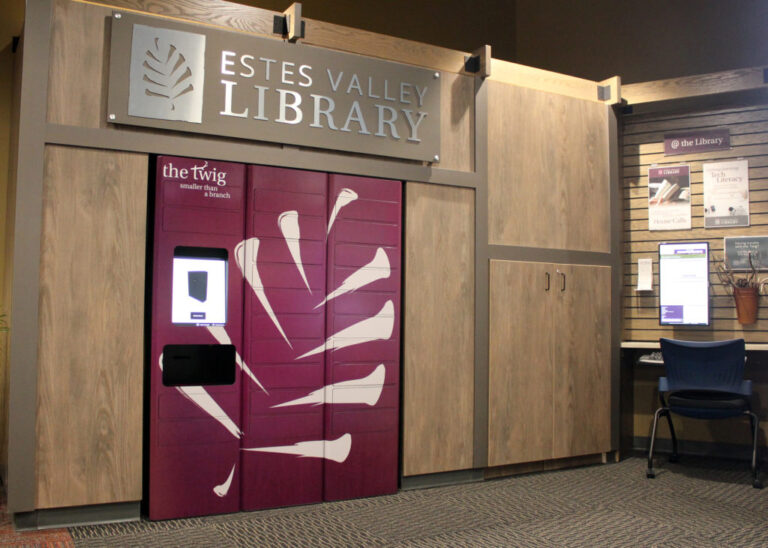
2019
On April 9, the Estes Valley Library Friends & Foundation celebrated the opening of Cliffhanger Used Books at 191 West Riverside Drive, offering thousands of gently used books, DVDs, and music CDs. All proceeds would help the Friends & Foundation in its mission to support the Library and its services. The bookshop would be staffed 42 hours a week by a team of volunteers. Three apartment units above Cliffhanger would serve as a first ever workforce housing option for library staff.
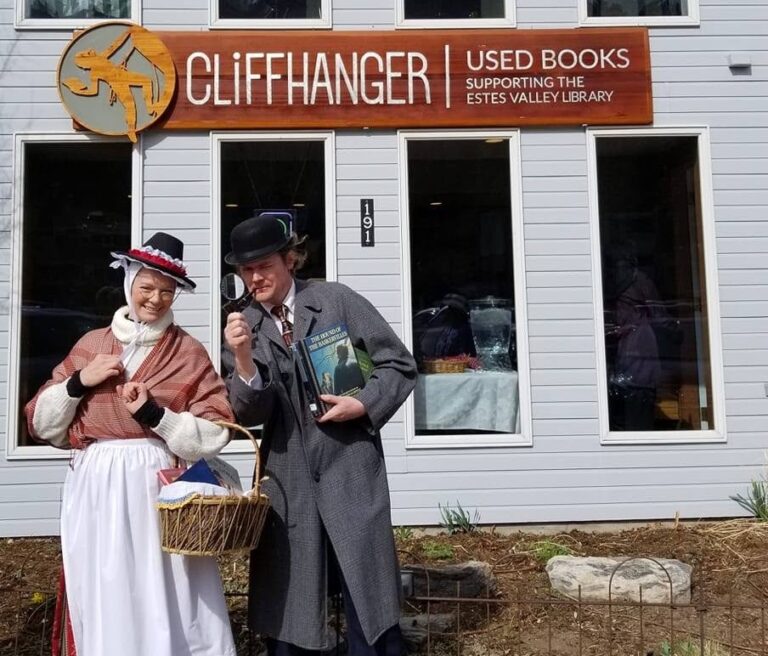
Seventy-eight volunteers contributed 3,614 hours of service to the library, while staff grew to 27.
Digital collections circulations reached an unprecedented 20,000, and the “Library of Things” saw a 66% increase in circulation. Thanks to a new online registration system for Summer Reading, adult program participants increased by 141%. The English Language Learning program had continued growth with 921 tutoring appointments held by 39 volunteers.
In one effort to fulfill the library’s Green Initiative, highly efficient LED lighting was installed throughout the entire building. The Library and the Estes Park Museum made great strides with the Historic Newspaper Digitization project, providing 1925-1948 of the Trail Gazette in high resolution, word-searchable content, available online.
2020
The Library spearheaded a community-wide campaign to create the Village Catalog: one mega catalog that now includes collections from the Library, all three Park R3 District school libraries, and Eagle Rock School. The collection totals over one million items, physical and digital, all available at catalog.estesvalleylibrary.org.
On March 17, the major global event came to the Library’s front door: the COVID-19 pandemic caused the building to close. Many services remained “open”: first via chat and phone, then later with curbside delivery. Patrons borrowed collection items online, then traveled to the Library and remained in their cars while masked Library staff deposited their orders in the trunk. Curbside service was one of many pandemic-influenced services that staff implemented. Others included virtual community “Zoom rooms,” Grab & Go kits, and virtual programming. Many of these creative additions are still active services today.

The first floor reopened to public visitation on June 16. The Library became a point of distribution for COVID test kits and masks, assisting in protecting the health and safety of our community.
October brought other challenges to the Library’s doorstep: the Cameron Peak and East Troublesome fires caused an entire evacuation of the Estes Valley. Luckily, our heroic local, regional, and federal first responders (along with some help from Mother Nature) kept the fires at bay and the Library reopened later that month.
In the spirit of local collaboration and partnership, paired with valuable and productive discussions, the Library joined forces with Estes Valley Restorative Justice Partnership to start Community Conversations. These monthly events focused on creating space and building capacity for Estes Valley residents to engage on difficult issues.
2021
Due to COVID-19 related restrictions, the pandemic continued to impact daily life, including how patrons used and engaged with the Library. Grab & Go kits remained popular and many programs stayed virtual (including popular and signature events like One Book One Valley and Young Chautauqua).
Joyfully, the Library’s second floor reopened on July 6, more than a year after the building closed due to the pandemic.


